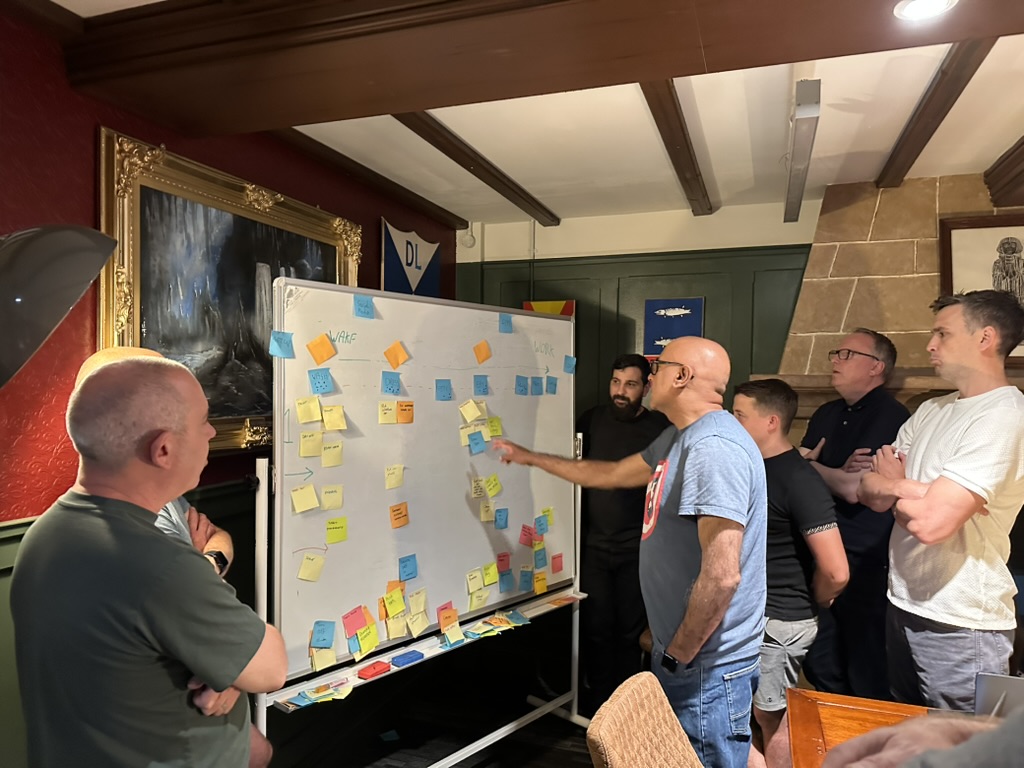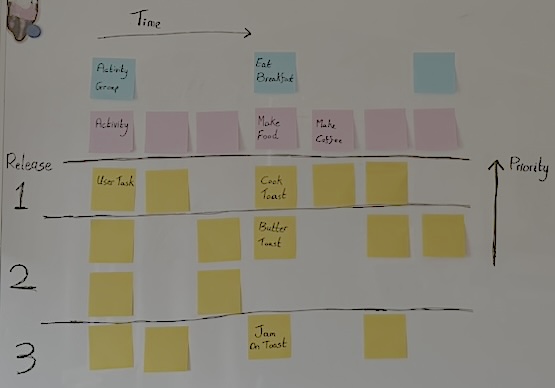
Dan Edwards - July 2025

The Morning Routine Game is taken from Jeff Patten’s excellent book: User Story Mapping
We’ve used this game both internally and with clients. It’s a great introduction to User Story Mapping, helping teams to define project scope, user stories, and release candidates.
It’s a simple activity for which you’ll only need sticky notes, some pens, and a surface to stick the stickies. The activity will take an hour or so.

To get a feel for User Story Mapping (USM), it's good to take a process which is familiar to everyone, creating a level playing field for all involved. The 'morning routine’ is a great example to choose, as there's a good chance that everyone in the group gets up in the morning and starts work.
Our goal is to understand the activities involved in the process (morning routine) and to break down these activities into user tasks which we can ultimately align to a release. User Story Mapping is the tool that will help us achieve this.
Allow up to 3–5 minutes for each member to identify the key steps in their morning routine — from waking to leaving the house. For those working from home, perhaps ‘leaving the house’ is equivalent to sitting at their desk. Write the activities on stickies — one sticky per activity.
At the end of the time limit, have the group place their stickies on the board, arranged left to right in order along the timeline. These activities form the ‘backbone’ of your project. For this example, the backbone would contain activities such as ‘eat breakfast’ and ‘shower’.
Have the group work amongst themselves to determine the order of activities — this is a great opportunity for the team to discuss and agree on the order.
This is a fun part of the activity, and as with a real project, you’ll find unexpected issues with conflicting opinions… Do you brush your teeth before or after eating? It’s the hygiene equivalent of tabs vs. spaces — to which there is only one correct answer 🙂.

There’s most likely a lot of stickies on the board now — this is because your team is made up of folks with differing domestic arrangements. What we’ve not done is consider personas.
Who is your target audience? Are they pet owners? Not everyone will have to walk their pet before work (this is typically the prerogative of dog owners, but cat owners should not feel excluded). Perhaps we can exclude pet ownership from the persona for the time being.
Can you narrow the persona(s) down further?
ℹ️ Some would argue that your personas should be defined before this stage in the process, and that is certainly a valid point. However, for our example, defining the personas at this stage really emphasises the value of personas.
Having identified the persona you're targeting, remove those activities that would not apply to that persona.
Once the backbone has been established, prioritise the tasks under the remaining activities. Split the team into groups of 2–3 folks and let them tackle one activity each, arranging the stickies vertically in priority order (top tasks highest, bottom tasks lowest). Have each team discuss their rationale for the priority choices and discuss if there’s anything seemingly controversial.
Note that each User Task maps very neatly to a User Story.
Keeping the same groups, now split the User Tasks into releases — what do the teams feel needs to be in the first release, what can be deferred to a later release. Again, discuss these release suggestions and sizes in the group.
Now throw in a few scenarios to test your release mapping:
Has the discussion around these scenarios changed your release plan?